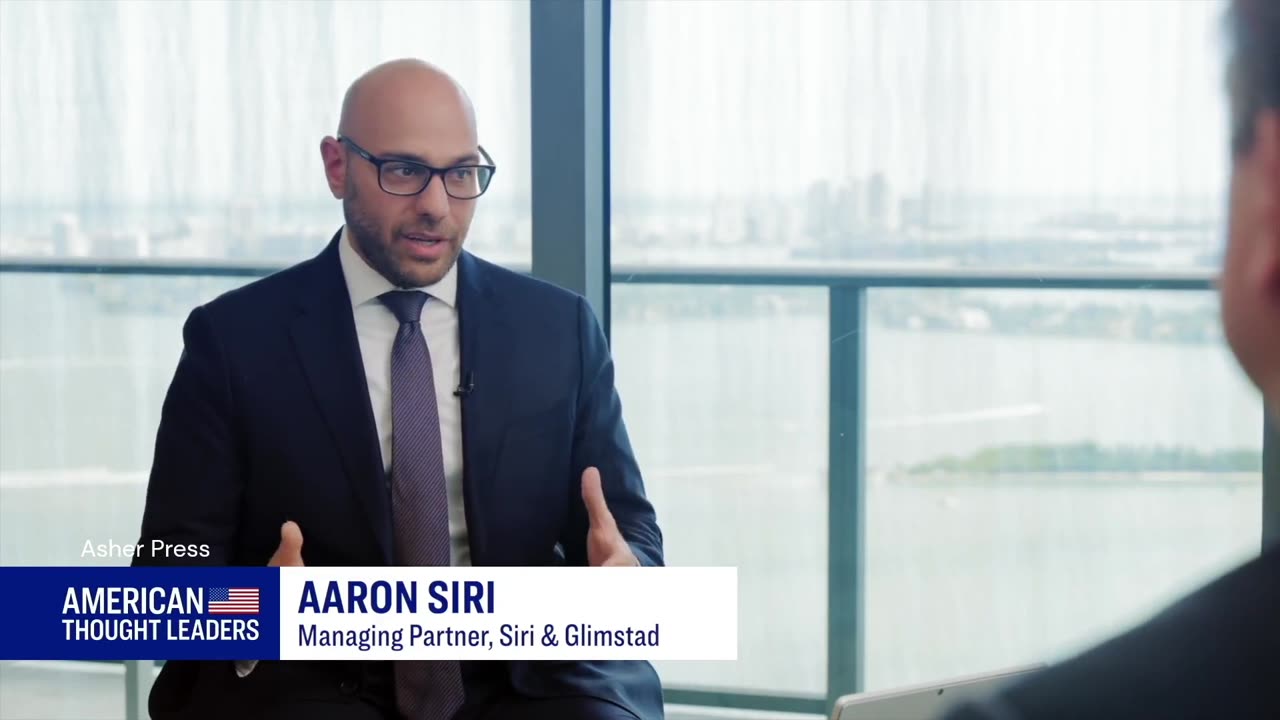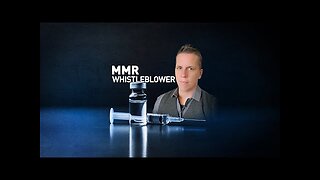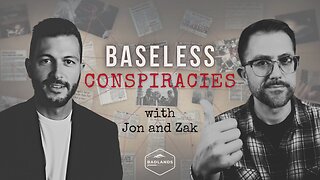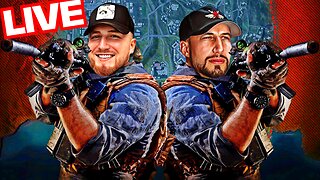Premium Only Content

"7.7 percent of 10 million V-safe users reported needing medical care after a COVID-19 vaccine.” - Aaron Siri Part 1
Watch the entire interview: https://rumble.com/v2ki7g2-aaron-siri-part-1-why-are-vaccine-manufacturers-the-most-protected-companie.html?mref=1bxo9j&mc=69gy3
Part 2 (clip):
https://rumble.com/v2ayi8w-hepatitis-b-vax-testing-involved-only-147-kids-and-5-days-of-safety-monitor.html
Part 1:
“When we finally had that data, you got a sense of why they didn’t want the public to have it, because it showed that 7.7 percent of the over 10 million V-safe users reported needing medical care after a COVID-19 vaccine.”
Aaron Siri, managing partner at Siri & Glimstad, has led several high-profile lawsuits against vaccine manufacturers and federal health agencies since the start of the COVID-19 pandemic.
“If they prevail … in five to 10 years, what will happen is it will reset the normal health baseline in America for heart issues, cardiovascular issues, right? That will be the new normal,” Siri says.
In this comprehensive two-part interview, Aaron Siri breaks down how vaccine manufacturers secured unprecedented protections from liability three decades ago.
“There is no other product that I’m aware of that is afforded this level of protection,” Siri explains. “When you look around you, all the products you experience every day, they’re safer because the manufacturer is worried about liability.”
Siri was always told that vaccines are safe. But if a product is safe, he explains—at least in the way that public health agencies project it to be safe to the public—the injuries would be exceedingly rare, and thus, there would be no need for the manufacturer to be granted immunity from liability.
“They were going to stop producing those vaccines because they could not make a profit because the amount of liability they had to pay exceeded the revenue,” Siri says. “You learn things along the way that you just can’t unlearn.”
FULL TRANSCRIPT
Jan Jekielek:
Aaron Siri, such a pleasure to have you on American Thought Leaders.
Aaron Siri:
Pleasure to be here.
Mr. Jekielek:
Aaron, you are very, very serious about mandates, mandates of any sort of foreign substance being put into someone’s body. You are deeply against these things, and you’ve done a number of court cases related to this, most recently around the COVID-19 genetic vaccines. Let’s start here, because your law firm focuses on this now. How did you get into this?
Mr. Siri:
I should just say I’m not deeply against people taking medical products, or injecting medical products. In fact, I fully support everybody’s right to take as many medical products as they want, as many times as they want. The only opposition that I have is when you force somebody to do it, either through coercion and punishments when they don’t want to, because it’s just a basic civil right that everybody should be able to make their own medical choices without coercion.
In terms of how I got into this, so to speak, I was a commercial litigator for many years. Somebody I had worked with at a firm that I had been with for many years, Latham & Watkins, was going to go work with the Department of Justice; he had gotten a job there. And at this point in my career, I had left my former firm, one of the biggest firms in the country where that represents Goldman Sachs. He contacted me and said, “I’m going to work for the Department of Justice. I’ve got this flu shot case where I have this nurse who’s seriously injured from a flu shot, and I can’t represent her anymore, because I’d be conflicted.” Because it’s the Department of Justice that defends against all of these lawsuits brought by people claiming a vaccine injury.
If you’re injured by a vaccine you can’t sue the manufacturer, you have to sue the federal government, the Secretary of the Department of Health and Human Services, in something called the Vaccine Injury Compensation Program, part of the U. S Court of Federal Claims. He asked me if I would be interested in taking the case, because I had done some related work up until that point, and so I said, “Sure.” I took the case on, and we ended up obtaining compensation for a case from the flu shot, and there were a number of other cases at the time that I took on in a related kin, I should call it. And you learn things along the way that you just can’t unlearn.
Mr. Jekielek:
One of the things you learned was that you’re suing the Secretary of Health and Human Services? How many people know this, or even that this is the reality?
Mr. Siri:
I remember that was one of the very first things I learned about vaccines, these products. I remember working at a law firm where I looked it up and it was the National Childhood Injury Act of 1986. I looked at it and I was incredibly surprised. If anybody out there wants to look it up, it’s 42 U.S.C. 300aa-11. Just type in what I just said, and you can read that section of law, read the third paragraph, and in effect, it says that you cannot sue a vaccine manufacturer or administrator for any injury or death from a vaccine.
I remember thinking, “Wow. I know that gun manufacturers have some level of immunity to liability, but we know guns can be dangerous. I know that nuclear power plants have a level of immunity to liability given to them by Congress as well, if there is a nuclear meltdown, but we know nuclear power can be dangerous. But I was always told the vaccines are safe. If the product is safe, why do you need to effectively give the manufacturer blanket immunity to liability for the injuries that that product causes? Because if it’s safe, certainly in the way that our public health authorities project it’s safe to the public, there shouldn’t be any injuries or there should be one in a million, as you often hear.”
Mr. Jekielek:
And you hadn’t thought about this before?
Mr. Siri:
No. I just thought the same thing everybody else thought. I drink water because that’s good for me. I eat healthy food because that’s good. I go to sleep every night. What is generally projected about these products by public health authorities typically is that, similar to water, food and sleep, you get vaccines. But that was an eye-opening moment. When I looked into it just a little further, it didn’t take much to scratch the surface. And then you say, “Okay, why then? Why did they get this immunity?”
You can read the Wyeth v. Bruesewitz U.S. Supreme Court decision of 2011 that even discusses it. Part of what that explains is that the liability that vaccine manufacturers were facing leading up to 1986 was so great, that either Congress had to step in and give them immunity liability, or at that point, with the three routine vaccines given to children—that’s all there were, three, and there was only one manufacturer left for each—they were going to stop producing those vaccines, because they could not make a profit due to the amount of liability they had to pay exceeded the revenue.
But that’s how it works in America. If your product is causing more harm than it is good, the way we measure it, for better or worse in America, is by dollars. Then, you have to go make a better product. You have to go make a safer product. Had Congress just done nothing, and just let the market forces do what they do, those vaccine manufacturers, would they have just gone out of business? No, they’re in the business to make money. They probably would have retooled, and made a better product, and presumably, a safer product.
But Congress in its wisdom said, “It’s okay. You can keep selling your vaccines that are causing a level of harm that is making you almost go out of business. We’ll just give you immunity, so nobody can sue you.” So, the vaccine manufacturers were given immunity to liability for their product, and not only for the three vaccines that were routinely given then, but for any future routinely recommended childhood vaccines, prospectively.
And it was that act, it was that immunity to liability, that in my opinion, has set off the cascade of events that we now see manifesting today around these products; how they’re viewed, how the public views them, how our health authorities treat them, and how pharma has been able to basically run amok. There is no other product that I’m aware of that is afforded this level of protection.
When you look around you at all the products you experience every day, they’re safer because the manufacturer is worried about liability. Your car is safer, not because of some regulatory agency, maybe to some degree, but it’s because they don’t want to get sued, and they don’t want to have to pay billions of dollars in damages. With virtually every product you interact with in America every day, the manufacturers can be sued for design defects, claims that the product could’ve been made safer, and claims that they failed you to warn about risks.
But you can’t sue pharmaceutical companies with regards to those claims in the same way for vaccine products. What that has essentially done, it has left pharmaceutical companies for the last over almost 40 years with complete control of the narrative around these products, and they’ve done a very good job in making sure that the public thinks their products are great.
Mr. Jekielek:
You’ve been involved in a few quite high-profile cases, probably many. There are two that come to mind. One is the Pfizer clinical trial data lawsuit. The other one is the V-safe data lawsuit, which you talked about at the recent hearing in December that Senator Ron Johnson held. Why don’t you give me an overview of the V-safe piece? A lot of people might be familiar with the Pfizer data, and maybe we can look into that more, but please explain why you went after the V-safe data, and what exactly is that?
Mr. Siri:
The vaccine policy work that our firm does, and we have a big vaccine injury practice and we have a vaccine exemption practice. But the core of our vaccine practice is the vaccine policy work. Most of that is done on behalf of a nonprofit called the Informed Consent Action Network. It’s a nonprofit started by an individual named Del Bigtree.
The Informed Consent Action Network asked us to get the data from the V-safe database. The V-safe database is what the CDC basically calls it, its premier safety system for COVID-19 vaccines. It was rolled out specifically for COVID-19 vaccines. For decades, the CDC has said that their VAERS [Vaccine Adverse Event Reporting System] database is their premier database for assuring vaccine safety essentially. It’s their signal detection system.
If there’s a problem out there with a vaccine, they’ll pick it up in VAERS, saying, “Don’t worry.” And then, they will go to other databases to assess it. All of a sudden, just as the first COVID vaccine was about to be authorized in December 2020, the CDC and the FDA actually started changing their tune about VAERS. They very quickly changed their tune about it, after lots of reports started coming into VAERS. They started saying, “Actually, there are issues with VAERS, and so we’re going to roll out a new system called V-safe and this is going to help us,” and these are the CDCs words, “rapidly detect issues with the COVID-19 vaccine safety issues, so that we can address them.”
In designing V-safe, the CDC basically had check the box options and it had a free text field. It had two categories of check the box options. The first category was asking people for one week after the COVID-19 shot to check the box about 18 or so symptoms, whether they experienced them, and whether they were low, mild or severe.
The thing is, those symptoms are the same symptoms that the CDC tells you are normal, and are in fact good for you to have after a COVID vaccine, they call it reactogenicity. They say that those symptoms show the vaccine is working, and that you are having an immune reaction, which is what they want you to have after the vaccine. They don’t want it to be severe, but they want you to have it. The truth is, no matter how high those rates would have been reported, it wouldn’t have mattered. So, that data is basically useless.
Then, there’s a second category of check the box data in V-safe that was collected, and that was one of three options that users could have checked. One; did they need medical care? And then, they could have sub-checked whether it was hospitalization, urgent care, emergency room, or telehealth. The second one they could have picked; did they miss school or work? And the third option that was provided; were they unable to perform normal daily activities?
It must be in what the CDC said is their rapid detection system to ensure the safety of the COVID-19 vaccines, it was in those three options where they were going to assess safety. Where else would it be? So, ICAN, my client, wanted to know at what rate did people check they needed medical care after a COVID-19 vaccine?
Presumably, that’s basically the only metric you’re really asking the people using V-safe to provide in a systematic way, where you could get an enumerator and a denominator. You can say, “Here’s the number of people that say they need medical care, and here’s the total number of V-safe users; divide that and you have a rate.
We asked the CDC, “Can you provide that data?” The CDC said, “No.” As usual with our health agencies, despite their claims of transparency, we had to sue them in federal court to get the V-safe data. In the first lawsuit, they raised objections that were interesting. So, we bought a second lawsuit that basically addressed their objections in the first one to lock them in. At that point, they finally capitulated—it took almost a year-and-a-half—and they provided all the check the box data in V-safe.
When we finally had that data, you got a sense of why they didn’t want the public to have it, because it showed that 7.7 per cent of V-safe users, out of a little over 10 million V-safe users, reported needing medical care after a COVID-19 vaccine. These 10 million users, these are not folks that are like with VAERS, they are just using the system to report an issue. They are signing up right when they get the shot, at the CDC’s urging, and most of them signed up in December 2020, in the first few months of the vaccine’s rollout.
These are folks who are the enthusiasts, they were going out to get the shot. These are the ones who are fighting, clamoring over each other to get the shot. Nobody’s being mandated to get it. When 7.7 per cent of them are reporting needing medical care, it’s probably a very good reflection of the full population that got the vaccine. You probably can extrapolate, and if anything, it is probably underreported, because they were more likely to be vaccine enthusiasts.
Of that 7.7 per cent, there was another 25 per cent that separately reported being unable to go to school or work, and weren’t able unable to perform normal daily activities. So, 32 cent of folks reported having some issue. And so, the fact that a medical product can cause you to go to the emergency room, that is not shocking. I mean, drugs get pulled from the market all the time.
What’s concerning here is the CDC province transparency. During the year-and-a-half that they were hiding this data from the public while we fought with them to get it, repeatedly, they were publishing over a dozen studies using V-safe data, and relying on V-safe to promise the public that these vaccines are safe. And when you look at those studies, what did the CDC include in them?
They only included the first week of data reporting in V-safe, of people needing medical care after the shot. And that rate was something like half-a-percent. First of all, I don’t know why one in 200 people needing medical care after the COVID shot in the first week is somehow comforting. When you look at subsets in the V-safe data, which we now are able to do, it’s as high as 3 per cent in the first week for certain subsets, if you do by age and shot, which should be extremely concerning. But even half-a-percent, that should be concerning.
They publish that to the public knowing that injuries from vaccines don’t only arise in the first seven days after a shot. We do cases in the Vaccine Injury Compensation Program all the time. It is well known that immunological issues with vaccines often take at least a week to manifest. It doesn’t just happen in a minute. You have to build up those self-antibodies that cause a problem, and that takes time.
This idea that the first week is somehow representative of safety, they know that’s not the case. They’ve had that full dataset for a year-and-a-half. They used only the first week to claim it’s safe, where had they looked for the first six weeks, that number is way larger. They knew that, and they never disclosed it to the public. And it wasn’t like the public wasn’t asking; we were demanding it, and we were suing them over and over for it. This is very concerning.
Mr. Jekielek:
There is another issue. If I understand it correctly, they already knew at the outset from some FOIAs that we did, that there were very specific adverse reactions to these vaccines. So, it would not have been too difficult to include those in one of these dropdown menus.
Mr. Siri:
Yes. What you’re talking about is, as part of the lawsuit we did on behalf of ICAN against the CDC, we not only ask for all of the data in V-safe, we also ask for all the documentation and communications surrounding V-safe. And some of that documentation included the protocol that the CDC published for designing V-safe. And there were many iterations of that protocol.
Version one of the protocol was from before December 2020, as you would expect. If you’re going to design the system, you need to have the protocol, the design document before you launch it. That first protocol from a few months before V-safe was launched, if you go to the very last page, it has what was labeled adverse events of special interest in a table that’s entitled pre-specified conditions.
It listed 15 medical conditions, many of which are now the same issues that people with COVID vaccines are saying they are experiencing; myocarditis, pericarditis, and transverse myelitis. You can go down the list and see them. The CDC knew about those conditions, and knew the COVID-19 vaccine could likely cause them, before it launched V-safe.
It had an opportunity to take those 15 conditions and make them check the box options in V-safe. Had it done that, we would be able to calculate a rate for these conditions among the V-safe users like this; if 500,000 people using V-safe reported myocarditis and you had 10 million users, that’s 5 per cent, 500,000 divided by 10 million and boom, you would have a rate. That would give you real safety. When the CDC called it a rapid system for detecting safety, that would have been rapid. You would actually have that.
When you think about criminal cases or criminal law, what you need to prove is called scienter. You have to prove a guilty state of mind, that the person acted with forethought, and that they knew what they were doing was wrong. Here the CDC was aware, it itself listed myocarditis, and many of the issues we see today as adverse events of special interest. It is very aware that by not including those as check the box options, it relegated people who wanted to report those issues, to a free text field that is included in V-safe.
People would just type it in, but nobody types in the same thing the same way. Somebody says, “I have a heart chest pain, I have a heart attack, I’ve got heart issues, my arm hurts, I’ve got tingling in my side, tingling in my right arm, tingling my left arm.” People report cardiovascular issues in hundreds of different ways. Taking those free text fields and then trying to standardize them and create a rate would be very difficult.
Moreover, it clearly never intended to release to the public what was actually written in those free text fields. How do I know that? Because they’re refusing to do it in the federal lawsuit we are in. They have taken a position in our federal lawsuit that they will not disclose the data in those free text fields. The CDC; were they just negligent, or did they really go into this with some forethought to try to hide harms?
To me that is probably one of the best pieces of evidence. They went into this knowing this shot could cause these harms, and they designed V-safe in a way that would allow them, if it came to be that the vaccines caused harms, that they could hide that data, and not have to disclose it to the public, or at least they were hoping for this. The lawsuit is far from over.
Mr. Jekielek:
Incredible. I want to mention, having a background in survey and experimental design, 10 million is a pretty good sample size. What you’re saying that it is likely representative of the general population makes a lot of sense.
Mr. Siri:
Yes, and in many ways it’s better than the Pfizer data. With the Pfizer clinical trial data, it got a lot of news that about 30,000 people were in the clinical trial. That data was filtered through Pfizer before it got to the FDA, and then got released to the public. And what do they do in the clinical trial? They ask participants to tell them about issues.
What does V-safe do? It asks participants to tell them about issues.
But instead of asking 30,000 people, it asks 10 million. And instead of having to filter through Pfizer, it just goes straight to the public without that filter. That’s why, in my opinion, with the V-safe data, that 7.7 per cent number is probably the best reflection of the safety of COVID vaccines you’re likely to ever get on a mass scale out of our health authorities.
Mr. Jekielek:
Compared to VAERS, it has the denominator, which is critical at figuring out what rates are.
Mr. Siri:
Right.
Mr. Jekielek:
It’s not just a signal, it’s an actual rate.
Mr. Siri:
That’s right. With VAERS, you don’t know what denominator to use. If you find 10,000 reports of an issue, you don’t know what you divide that with. How many people that had the issue are reporting it to VAERS? Out of what universe of individuals, you just don’t know. It’s harder to calculate a rate. Although I will say pre-COVID, HHS, with the agency for Health Research and Quality, with an HRQ-funded study, one of our health agencies, funded Harvard Pilgrim and Harvard University scientists to do a study of VAERS.
In that study they noted that less than 1 per cent of adverse events are reported to VAERS. I think that rate probably increased during the COVID era, but that number is probably very accurate. It was less than 1 per cent before the COVID era, and probably not much more than that after the COVID era.
Mr. Jekielek:
It’s very interesting to me that you said that prior to 2021, VAERS was considered to be the premier safety system. I didn’t know what VAERS was until recently, in the last few years. All I’ve heard is that it’s this discredited system because anyone can report. But you’re telling me for the history of vaccine safety, it has been a very different tune.
Mr. Siri:
Yes. The fact that you’d never heard of it and most folks hadn’t heard of it, and actually even many doctors had never heard of it, is why the rates in pre-COVID, not surprisingly, were probably far less than 1 per cent of the actual injuries from the vaccines that you find in that system. But to answer your question directly; yes, pre-COVID, if you go and look at the peer-reviewed literature around vaccine safety, which is very thin, pick a vaccine, go to PubMed, and try and see how many studies you can find on that particular vaccine, how many safety studies, and you’d be surprised there are not very many.
We know this because at our firm, when somebody calls us up, and says, “My child got a shot and was totally healthy and totally fine, and then all of a sudden developed X issue. Where do we go? We start with the clinical trial data, which is usually useless for childhood vaccines, because the safety review period is ridiculously short, there’s not enough people in the studies, they are not well powered and there’s typically no placebo control, actually there’s virtually never any.
We then go to the post-licensure studies and there aren’t many. But the few that there are, and many of them are from our health authorities, often use what database? VAERS. And what they did, especially in pre-COVID, is they would use the lack of a safety signal in VAERS to say it’s safe. They say, “You can’t use VAERS to establish a safety issue because it’s only a signal detection,” meaning if there’s a quote unquote, “signal,” that doesn’t mean the vaccine causes that issue, that just means they have to do further studies.
These studies, by the way, rely on data which they won’t make available to you, because they’ll use something called the Vaccine Safety Datalink, and they have one or two other systems. They will not give you the underlying data, contrary to the way science is supposed to work. The underlying data study should be available for everybody to look at, but they won’t let you see it.
When I say pre-COVID vaccine era, they always maintained that VAERS could not be used to establish causation or to show a vaccine causes an injury, but they frequently used it to say a vaccine is safe, because they can’t find a signal for an issue. And they’ve continued to do that even during the COVID era. VAERS could only be used to show a vaccine is safe, and it could never be used to show a vaccine has an issue.
Mr. Jekielek:
Fascinating. You said a couple of things again that I find very disturbing. One of them was something about very, very short safety review periods for childhood vaccines. I’m going to put a pin in that.
Mr. Siri:
Sure.
Mr. Jekielek:
But we definitely have to hit that. You can’t just casually say something like that. So, I’m going to hit you up on that again.
Mr. Siri:
Sure.
Mr. Jekielek:
In terms of harms, there is a lot of discussion about vaccine harms. The most recent interview as we’re recording here is with someone who was harmed in the AstraZeneca trial, Brianne Dressen, who’s working with about 21,000 people who have been injured as part of the React19 project that she runs. Is there any way to measure the harms associated with COVID-19 genetic vaccines and everything that’s come before? Is there a way to assess that?
Mr. Siri:
I can’t tell you definitively because the studies to answer the question that you just posed have not been done, or have not been done with large scale, robust studies that I would like to have at my fingertips. These are studies that could easily be done using retrospective data and existing databases, whether they be insurance databases, or whether it be the Vaccine Safety Datalink that has tens of millions of people in it, which includes thousands or tens of thousands of completely unvaccinated children.
All you would have to do is take that existing data. You don’t need to leave any child unvaccinated, these kids were already not vaccinated. All you have to do is look at their health outcomes. In a captive HMO environment, for example, you typically have all of those kids’ health records, with an insurance company like Kaiser Permanente. They give the insurance, and they provide the medical care. You could just compare all of what they call the ICD-9, ICD-10 codes, which are billing codes. Look at all the billing codes for the kids that are completely unvaccinated, and compare it to all the kids that have one or more vaccines. With those two groups, let’s look at the outcome.
What are the rates of the immune-related or immune-mediated neurological disorders that we have seen explode in children between 1986 and the present? What is the rate between those kids who got no vaccines and the kids that got one or more vaccines? In 1986, according to public health data, only 11 per cent of kids in this country had a chronic health issue. As of 2011, according to the CDC’s own data, around half of children in America today have a chronic health issue. I don’t think that definition has changed.
If you want to know the safety of the current childhood schedule, the rate of what you’re asking, that’s the comparison you should do. What I just described to you is a simple study to do, it’s not hard. I’m not the first person to ask for it. I am in a long line of stakeholders, and this has been going on for decades, asking for the study that I just described.
Even our own federal health authorities published an entire white paper, and they spent a million dollars to put it together on how to do exactly that study, in the Vaccine Safety Datalink, that system I described to you. After scientists were able to get access to it in 2000, the CDC then moved it out of the CDC and put it in a trade organization that represents HMOs so that nobody could FOIA it, and nobody can get access to it from the public. They literally created that transition.
That report itself verified there are thousands of children in that Vaccine Safety Datalink that are completely unvaccinated. They even did a check, a medical review of their medical records to confirm that in fact, what they’re seeing, the system reflects reality, and it was a very high statistical confidence level. Those kids have never gotten a shot. Our health authorities, they still haven’t done it. I shouldn’t say that, I should say they haven’t published it. I don’t know if they’ve done it, but I know they never published it.
Mr. Jekielek:
And you know, they won’t give it to you.
Mr. Siri:
You cannot get access to the Vaccine Safety Datalink. It’s about a dozen health systems around the country, Kaiser Permanente Southern California, Kaiser Permanente Northern California, and various others. What they do is take all of the billing codes, and strip out all personal identifiable information, so you can really never go back and figure out who anybody is.
They have the vaccination information, and then they take that de-identified data and they put it in a database, so that you could then query it and you can run searches between somebody who got these vaccines, and then what medical conditions were they diagnosed with? You can do that comparison, and you can have the rate that you’re talking about, and then you can have the data you need to compare what you’re saying is COVID-19 vaccine injury, with what the childhood vaccines cause, and how common is it?
Are childhood vaccines contributing to some degree or some stripe to the childhood chronic health issues, which would result in the adult health issues that we’re seeing? There have been smaller studies of that nature done, not by health authorities. There is, for example, a study out of the University of Jackson, Department of Epidemiology. It involved a few hundred kids, homeschool kids, and was based on parental surveys. It’s wonderful that the study was done. I give a lot of credit to the scientists who did it. It’s extremely brave to do that study, and then publish the results. Those results showed that children who had been vaccinated had 30 times the rate of rhinitis, compared to kids who had no vaccines.
Mr. Jekielek:
What is that? Just quickly.
Mr. Siri:
Rhinitis, there are various kinds. The important point is that it has an immune component, let’s put it that way.
Mr. Jekielek:
Okay.
Mr. Siri:
Actually, that was the case for the issues that they looked at. The rates between the vaccinated kids were multiple times for all kinds of health issues; ADHD, and various other health issues, than the unvaccinated kids. The unvaccinated kids had twice the rate of chickenpox, and the unvaccinated kids had more pertussis, but those are transient. The vaccinated kids had health issues that were chronic and for life.
I would like to see that study repeated in a few million parts and a large database and data set. But that should be a canary in the coal mine. That should make health authorities go, “Oh my gosh.” The other thing I’ll say is the difference between COVID vaccines and all other vaccines is this. The COVID vaccine was rolled out on the public all at once. Pretty much you saw almost the entire population or a very significant portion get a shot in a very narrow window of time. If there are health impacts, they would become a lot more pronounced and easier to pick up on. And you’re seeing that.
Most of the other vaccines were rolled out and slowly had uptake over two decades, even many of the common vaccines you think of. First of all, they’re only given to one age cohort of children; just four-year-olds, just six-month-olds, or just two-month-olds. It’s only given to a percentage of them when they’re first rolled out, only a small percentage. Only a very tiny fraction of our population in this country ever got any vaccine when it was first rolled out. It took a decade or two, two decades before even those who are just up to 20-years old got the shot, right?
And so, if it causes the health effect, what will happen is that the health effect would recede into the backdrop and would become the “new normal.” I’m not going to speculate. The important point is this; at the end of the day, the question of whether it causes this or causes that should be answered, and those studies should be done. Those who are saying vaccines are not properly clinical trialed, they’re not properly safety studied out, they are right. And they’re right no matter what the outcome, and they shouldn’t be chastised, and put down and attacked, as they are for just asking for the studies. They are the pro-science folks, in a way, though that term, I don’t even know what that means to most people, in any event. So, that’s a long way of answering your question.
Mr. Jekielek:
It’s fascinating because there is some way to measure this. But even this kind of long rollout versus the instant rollout obfuscates the reality somewhat.
Mr. Siri:
Oh, absolutely.
Mr. Jekielek:
It’s very interesting.
Mr. Siri:
Yes. 10 years from now, five years from now, I’ll make a prediction for you about those who seek to censor the current doctors and medical professionals that are trying to shine a light on the myocarditis, COVID pericarditis issue. If they prevail—and the CDC is working very hard, you can see their most recent data study and they’re saying that COVID itself causes worse heart and more cardiovascular issues—if that narrative wins out, in 5 to 10 years, what will happen is they will reset the normal health baseline in America for heart issues and cardiovascular issues. That will be the new normal.
The new normal will be what is now occurring in the hearts and cardiovascular systems of Americans after COVID vaccines. Had you rolled COVID shots out slowly over a 20-year period, that change in the cardiovascular issues, I would be shocked and very surprised if that connection would have been made. I shouldn’t say that. If it was made, it would not have anybody to really listen to it, other than the few people who would have been quick to cast off to the side.
COVID has been an incredible revolution in that it’s made many people look at vaccines for the first time; they saw the clinical trials happen, they saw the coercion, they saw the rollout, and they even saw how some of the science was being mucked with on natural immunity. It made them go, “Whoa, whoa, whoa.” They are actually paying attention. Scientists who take issue with these products—they’re just products—are actually getting on the media, and they’re being interviewed. There are many such scientists for Hep B vaccines. There were such scientists for many of the other vaccines. I know them.
This transcript has been edited for clarity and brevity.
Watch PART TWO of this interview here.
Subscribe to the American Thought Leaders newsletter so you never miss an episode.
* Click the “Save” button below the video to access it later on “My List.”
Follow EpochTV on social media:
Twitter: https://twitter.com/EpochTVus
Rumble: https://rumble.com/c/EpochTV
Truth Social: https://truthsocial.com/@EpochTV
Gettr: https://gettr.com/user/epochtv
Facebook: https://www.facebook.com/EpochTVus
Gab: https://gab.com/EpochTV
Telegram: https://t.me/EpochTV
World COVID News 🌎 https://Youtube.com/@TheAsherPress
https://Rumble.com/AsherPress
https://X.com/AsherPress
https://Instagram.com/AsherPress
-
 23:34
23:34
Asher Press
1 day agoMMR Whistleblower (+NYC subway crime) August 31, 2025 - Sharyl Attkisson
370 -
 1:37:19
1:37:19
Badlands Media
12 hours agoBaseless Conspiracies Ep. 148: The Delphi Murders – Secrets, Setups, and Cover-Ups
30.4K14 -
 5:59:05
5:59:05
SpartakusLIVE
6 hours ago#1 MACHINE Never Stops The GRIND || LAST Stream UNTIL Friday
132K1 -
 28:36
28:36
Afshin Rattansi's Going Underground
1 day agoDoug Bandow: ENORMOUS DAMAGE Done to US’ Reputation Over Gaza, Trump ‘Easily Manipulated’ by Israel
19.7K29 -
 2:45:13
2:45:13
Barry Cunningham
13 hours agoCBS CAUGHT AGAIN! CHICAGO A MESS! LISA COOK IS COOKED AND MORE LABOR DAY NEWS!
96.7K47 -

StevieTLIVE
7 hours agoMASSIVE Warzone Wins on Labor Day w/ Spartakus
23.6K1 -
 10:46:42
10:46:42
Rallied
13 hours ago $13.15 earnedWarzone Challenges w/ Doc & Bob
193K4 -
 3:26:25
3:26:25
Joe Donuts Live
6 hours ago🟢 Lost in Space with My Clones: The Alters Adventure Begins
32K4 -
 7:20:22
7:20:22
Dr Disrespect
15 hours ago🔴LIVE - DR DISRESPECT - TRIPLE THREAT CHALLENGE - WINNING AT EVERYTHING
217K12 -
 2:35:33
2:35:33
Chrono
7 hours agoBirthday-eve Stream | Helldivers II
27.7K1